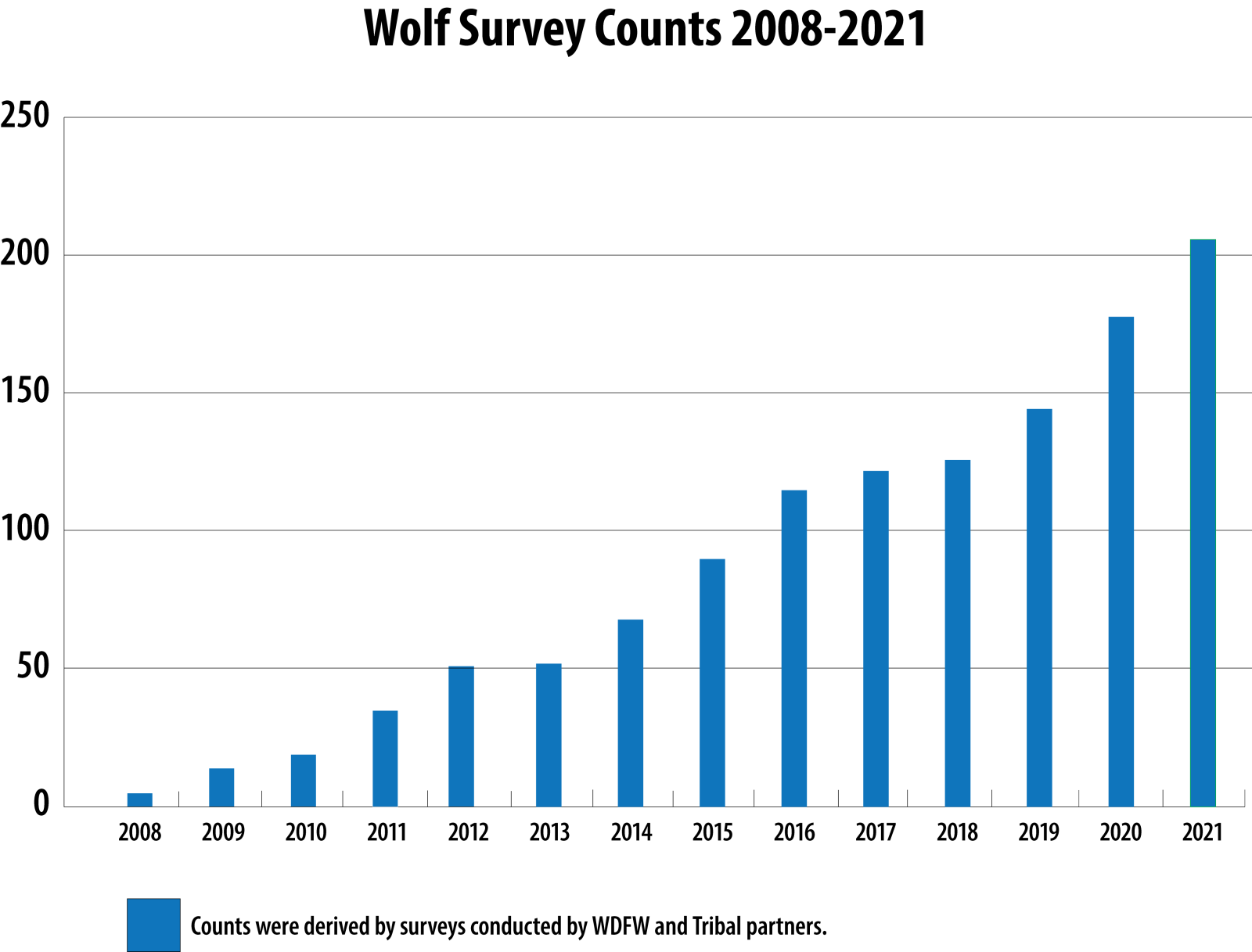ARCHIVED NEWS RELEASE
This document is provided for archival purposes only. Archived documents
do not reflect current WDFW regulations or policy and may contain factual
inaccuracies.
News release April 9, 2022
Julia Smith, (360) 790-1029
Staci Lehman, Public Affairs, (509) 710-4511
OLYMPIA – Washington’s wolf population continued to grow in 2021 for the 13th consecutive year. The 2021 annual wolf report was released today by the Washington Department of Fish and Wildlife (WDFW) and shows a 16% increase in wolf population growth from the previous count in 2020.
"Washington’s wolves continue to progress toward recovery, with four new packs documented in four different counties of the state in 2021,” said Washington Department of Fish and Wildlife (WDFW) Director Kelly Susewind.
As of Dec. 31, 2021, WDFW, partner agencies, and tribes counted 206 wolves in 33 packs in Washington. Nineteen of these were successful breeding pairs. This is up from 178 wolves in 29 packs and 16 breeding pairs in the 2020 count.
In 2019 and 2020, Confederated Tribes of the Colville Reservation (CTCR) provided numbers based on hunter, trapper, and public observation. For 2021, CTCR reverted to counting wolves through activities like track, aerial, and camera surveys- the same methods WDFW uses for the annual wolf count. As a result, numbers from the two counts have been merged together for this most recent count.
Because this is a minimum count, the actual number of wolves in Washington is higher. Since the first WDFW wolf survey in 2008, the state’s wolf population has grown by an average of 25 percent per year.
Four new packs formed in 2021 including the Columbia Pack in Columbia County, the Keller Ridge Pack in Ferry County, the Dominion Pack in Stevens County, and the Shady Pass pack in Chelan County. The Naneum Pack was not located during the survey; the two collared individuals in the pack dispersed from that area in November- one travelling through the Southern Cascades and Northwest Coast Recovery area and the other joined the Stranger pack in northeast Washington. As a result, that pack was removed from the tally.
Seventy-six percent of the known wolf packs in Washington were not involved in any known livestock depredation in 2021. Although eight packs were involved in livestock depredation, six of the eight were involved in two or fewer events each. As a result of depredations, two wolves from the Columbia Pack were lethally removed in 2021; one by the Department and one by a landowner with a permit to lethally remove a wolf.
“Although wolf-livestock interactions have remained consistent, we recorded the lowest number of livestock depredation incidents in the state since 2017 and removed the fewest wolves in response to conflict since 2015,” said WDFW Wolf Policy Lead Julia Smith. “We’re committed to promoting the proactive use of non-lethal deterrents to minimize wolf-livestock conflict, and proud to demonstrate that our approach is working thanks to the dedication of livestock producers, non-governmental organizations assisting directly with livestock monitoring, and WDFW staff.”
Since 1980, gray wolves have been listed under state law as endangered throughout Washington. In January of 2021, wolves were federally delisted from federal Endangered Species Act protection and WDFW resumed statewide management of the species. On February 10, 2022, wolves were federally relisted in the western two-thirds of the state and U.S. Fish and Wildlife Service (USFWS) once again has the lead role in the recovery of wolves in the North Cascades and the Southern Cascades and Northwest Coast recovery regions.
Contributors to WDFW's annual wolf report include the USFWS, the National Park Service (NPS), the Spokane Tribe of Indians, and the CTCR.
The Washington Gray Wolf Conservation and Management 2021 Annual Report is available from the Department’s website at wdfw.wa.gov. The report was presented to the Fish and Wildlife Commission and the presentation was recorded. That recording will be posted to the website soon.
The Washington Department of Fish and Wildlife works to preserve, protect, and perpetuate fish, wildlife and ecosystems while providing sustainable fish, wildlife, and recreational and commercial opportunities.
Individuals who need to receive this information in an alternative format, language, or who need reasonable accommodations to participate in WDFW-sponsored public meetings or other activities may contact the Title VI/ADA Compliance Coordinator by phone at 360-902-2349, TTY (711), or email (Title6@dfw.wa.gov).
